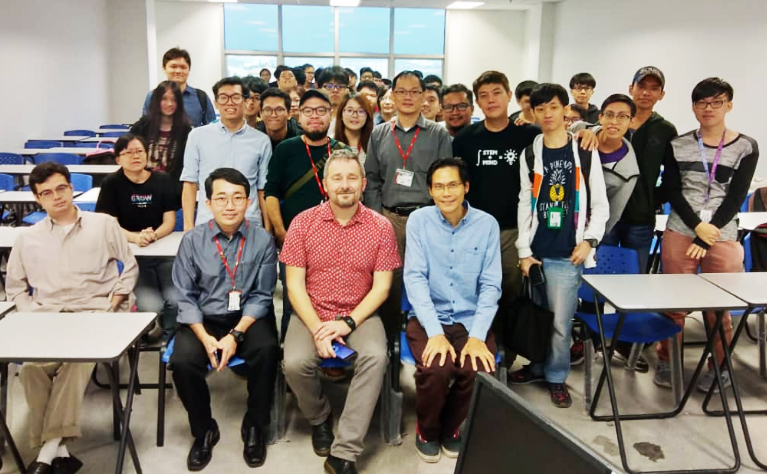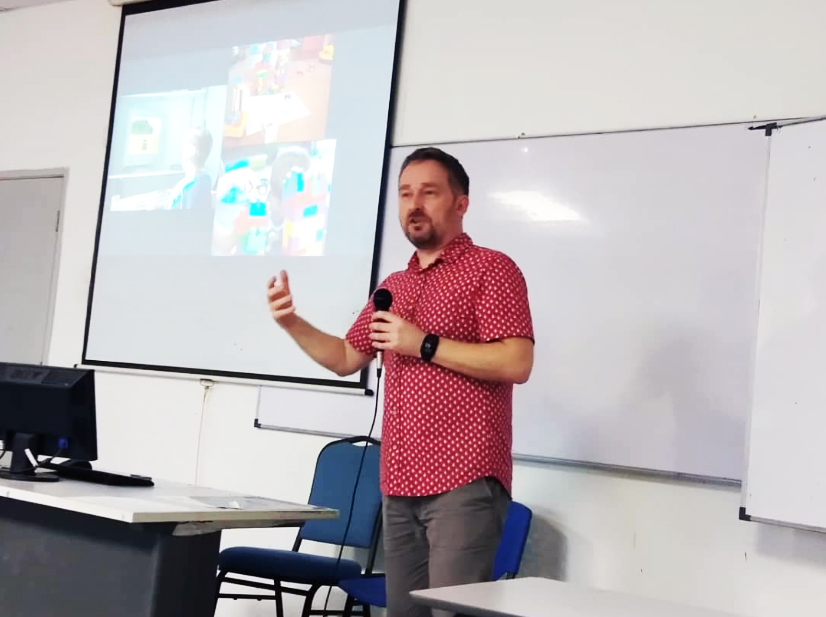


Front row, second from left: FCI Dean Dr David Tneh Cheng Eng and Dr Seth with the participants
A talk titled “Swings & Robots: Issues in design for postdigital play” was organised by Faculty of Creative Industries (FCI) on 31 January 2019 at UTAR Sungai Long Campus.
Invited to deliver the talk was University of Southampton Winchester School of Art Digital Culture and Design Assoc Prof Dr Seth Giddings. He is a media and cultural theorist, and occasional media artist. He has published widely on new media, video games and play culture, and media theory. His recent research was centred on ethologies, on the design of playful technologies, from mobile games to robots and playground swings.
Before the talk began, Dr Seth briefly introduced himself and his research, “My area of expertise is to study games as media objects, also the game lab. I work with children so that I can gain a better understanding towards their needs in games.”
During the talk, he shared his research projects with the audience through video screening, “Robot toy is one of my projects. This research was to teach the children about the gaming toy system. So, we ran a workshop with a group of primary school children in the United Kingdom (UK), to have a better understanding of what children want to see from a robot toy. We want to know what makes them excited. It is believed that by interacting with the children we can get an idea of what a robot toy means to a child.” He then continued, “We did not explain or show the children the robot toy that we designed in the beginning. Instead, we asked them to draw what they thought a robot might look like, and Star Wars was their answer based on their drawings. They do not really know what exactly a robot is.”

Dr Seth explaining his research project
“There is a big difference between having a physical object or technology to play rather than just asking your potential audience on what they want. At least, it could help them to broaden up their mind. Instead of just knowing Star Wars, they will start thinking about what an actual robot can do and how they actually move. It is also very important to test the projects with real people and real space, instead of just assuming that people might like your project very much,” said Dr Seth.
He then shared with the audience on his second research project, namely LED Swing through video screening, “This is actually quite a big project to innovate, to cope with technology invention plan. What is so special about this swing is, if it persistently swings, the frame will light up from bottom to top. Once it has reached the top, the whole thing will flash with music. This is how it attracts the children to queue up and play it again and again.” On top of it, the video also shows what the children have to say about the swing. He then continued, “As a researcher, my question was, why does this swing need lights for interactions? They are working well and children might play on it. So, is it merely adding more digital technology or what…?”
“This research project is about taking games off the screen into physical space and with an actual object, and that brings the thrill to the game challenge. This is the new method for studying the audience; instead of just asking them, have them physically engaged on projects. In postdigital culture, digital games are preliminarily important, but it has to connect with all sorts of parental entertainment, education and so on,” said Dr Seth in conclusion.
The talk then ended with a group photo session.
© 2019 UNIVERSITI TUNKU ABDUL RAHMAN DU012(A).
Wholly owned by UTAR Education Foundation Co. No. 578227-M LEGAL STATEMENT TERM OF USAGE PRIVACY NOTICE